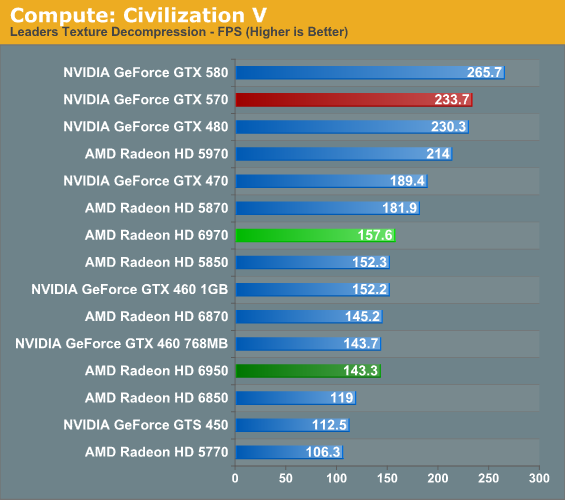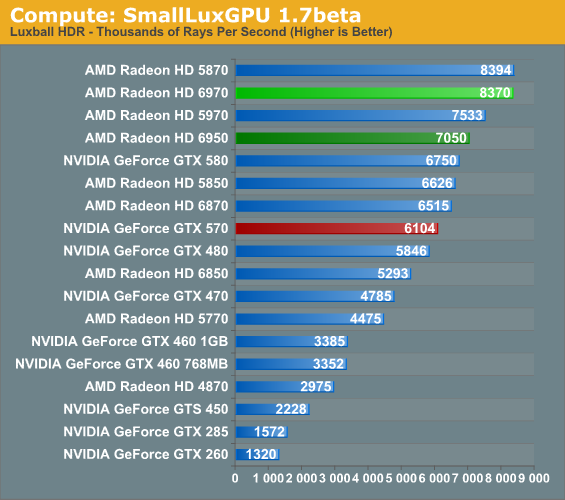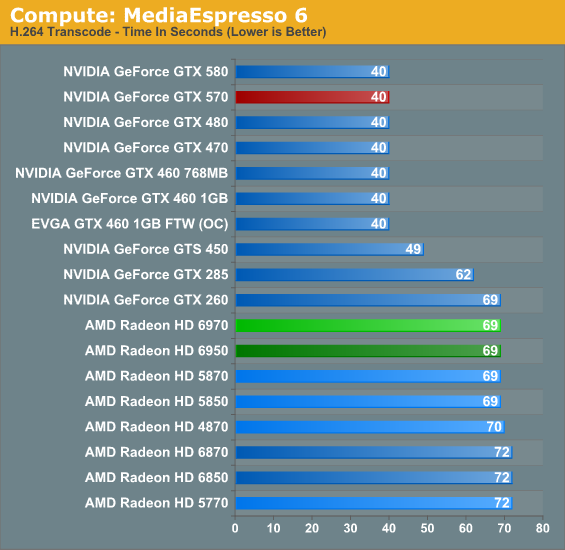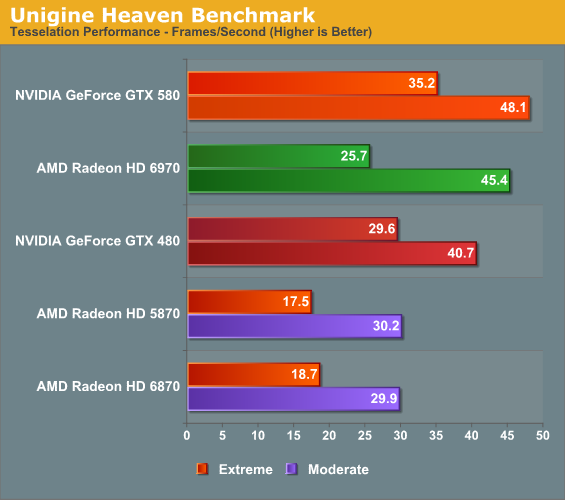AMD's Radeon HD 6970 & Radeon HD 6950: Paving The Future For AMD
by Ryan Smith on December 15, 2010 12:01 AM ESTCompute & Tessellation
Moving on from our look at gaming performance, we have our customary look at compute performance, bundled with a look at theoretical tessellation performance. This will give us our best chance to not only look at the theoretical aspects of AMD’s tessellation improvements, but to isolate shader performance to see whether AMD’s theoretical performance advantages and disadvantages from VLIW4 map out to real world scenarios.
Our first compute benchmark comes from Civilization V, which uses DirectCompute to decompress textures on the fly. Civ V includes a sub-benchmark that exclusively tests the speed of their texture decompression algorithm by repeatedly decompressing the textures required for one of the game’s leader scenes.

Civilization V’s compute shader benchmark has always benefitted NVIDIA, but that’s not the real story here. The real story is just how poorly the 6900 series does compared to the 5870. The 6970 barely does better than the 5850, meanwhile the 6950 is closest to NVIDIA’s GTX 460, the 768MB version. If what AMD says is true about the Cayman shader compiler needing some further optimization, then this is benchmark where that’s readily apparent. As an application of GPU computing, we’d expect the 6900 series to do at least somewhat better than the 5870, not notably worse.
Our second GPU compute benchmark is SmallLuxGPU, the GPU ray tracing branch of the open source LuxRender renderer. While it’s still in beta, SmallLuxGPU recently hit a milestone by implementing a complete ray tracing engine in OpenCL, allowing them to fully offload the process to the GPU. It’s this ray tracing engine we’re testing.

Unlike Civ 5, SmallLuxGPU’s performance is much closer to where things should be theoretically. Even with all of AMD’s shader changes both the 5870 and 6970 have a theoretical 2.7 TFLOPs of compute performance, and SmallLuxGPU backs up that number. The 5870 and 6970 are virtually tied, exactly where we’d expect our performance to be if everything is running under reasonably optimal conditions. Note that this means that the 6950 and 6970 both outperform the GTX 580 here, as SmallLuxGPU does a good job setting AMD’s drivers up to extract ILP out of the OpenCL kernel it uses.
Our final compute benchmark is Cyberlink’s MediaEspresso 6, the latest version of their GPU-accelerated video encoding suite. MediaEspresso 6 doesn’t currently utilize a common API, and instead has codepaths for both AMD’s APP and NVIDIA’s CUDA APIs, which gives us a chance to test each API with a common program bridging them. As we’ll see this doesn’t necessarily mean that MediaEspresso behaves similarly on both AMD and NVIDIA GPUs, but for MediaEspresso users it is what it is.

MediaEspresso 6 quickly gets CPU bottlenecked when paired with a faster GPU, leading to our clusters of results. For the 6900 series this mostly serves as a sanity check, proving that transcoding performance has not slipped even with AMD’s new architecture.
At the other end of the spectrum from GPU computing performance is GPU tessellation performance, used exclusively for graphical purposes. For the Radeon 6900 series, AMD significantly enhanced their tessellation by doubling up on tessellation units and the graphic engines they reside in, which can result in up to 3x the tessellation performance over the 5870. In order to analyze the performance of AMD’s enhanced tessellator, we’re using the Unigine Heaven benchmark and Microsoft’s DirectX 11 Detail Tessellation sample program to measure the tessellation performance of a few of our cards.

Since Heaven is a synthetic benchmark at the moment (the DX11 engine isn’t currently used in any games) we’re less concerned with performance relative to NVIDIA’s cards and more concerned with performance relative to the 5870. So with AMD’s tessellation improvements we see the 6970 shoot to life on this benchmark, coming in at nearly 50% faster than the 5870 at both moderate and extreme tessellation settings. This is actually on the low end of AMD’s theoretical tessellation performance improvements, but then even the geometrically overpowered GTX 580 doesn’t get such clear gains. But on that note while the 6970 does well at moderate tessellation levels, at extreme tessellation levels it still falls to the more potent GTX 400/500 series.

As for Microsoft’s DirectX 11 Detail Tessellation Sample program, a different story is going on. The 6970 once again shows significant gains over the 5870, but this time not against the 6870. With the 6870 implementing AMD’s tessellation factor optimized tessellator, most of the 6970’s improvements are already accounted for here. At the same time we can still easily see just how much of an advantage NVIDIA’s GTX 400/500 series still has in the theoretical tessellation department.










168 Comments
View All Comments
Ryan Smith - Wednesday, December 15, 2010 - link
AMD rarely has Linux drivers ready for the press ahead of a launch. This is one such occasion.MeanBruce - Wednesday, December 15, 2010 - link
Great job on the review Ryan, hope you will cover the upcoming Nvidia 560 and 550 when they arrive. Peace Brother!gescom - Wednesday, December 15, 2010 - link
Please Anand make an update with a new 10.12 driver. Great review btw.knowom - Wednesday, December 15, 2010 - link
Until you keep into consideration1) Driver support
2) Cuda
3) PhysX
I also prefer the lower idle noise, but higher load noise than the reverse for Ati because when your gaming usually you have your sound turned up a lot it's when you aren't gaming is when noise is more of the issue for seeking a quieter system.
It's a better trade off in my view, but they are both pretty even in terms of noise for idle and load regardless and a far cry from quite compared to other solutions from both vendors if that's what your worried about not to mention non reference cooler designs effect that situation by leaps and bounds..
Acanthus - Wednesday, December 15, 2010 - link
AMD has been updating drivers more aggressively than Nvidia lately. (the last year)Anecdotally, my GTX285 has had a lot more game issues than my 4890. Specifically in NWN2 and Civ5.
Cuda is irrelevant unless you are doing heavy 1. photoshop, 2. video encoding.
PhysX is still a crappy gimmick at this point and needs to offer real visual improvements without a 40%+ performance hit.
smookyolo - Wednesday, December 15, 2010 - link
PhysX may be a gimmick in games, but it's one of the better ones.Also, guess what... it's being used all over the 3D animation industry.
And guess where the real money comes from? The industry.
fausto412 - Wednesday, December 15, 2010 - link
physx is a gimmick that has been around for some time and will never take hold. when physx came around it set a new standard but since then developers have adopted havok more commonly since it doesn't require extra hardware.it's all marketing and not a worthy decision point when buying a new card
jackstar7 - Wednesday, December 15, 2010 - link
Alternately, my triple-monitor setup makes AMD the obvious choice.beepboy - Wednesday, December 15, 2010 - link
Agreed on triple-monitor setup. You can make the argument that 2x 460s are cheaper and nets better performance but at the end of the day 2x 460s will be louder, use more power, more heat, etc over a single 69xx. I just want my triple monitor setup, damn it.codedivine - Wednesday, December 15, 2010 - link
Any info on cache sizes and register files?